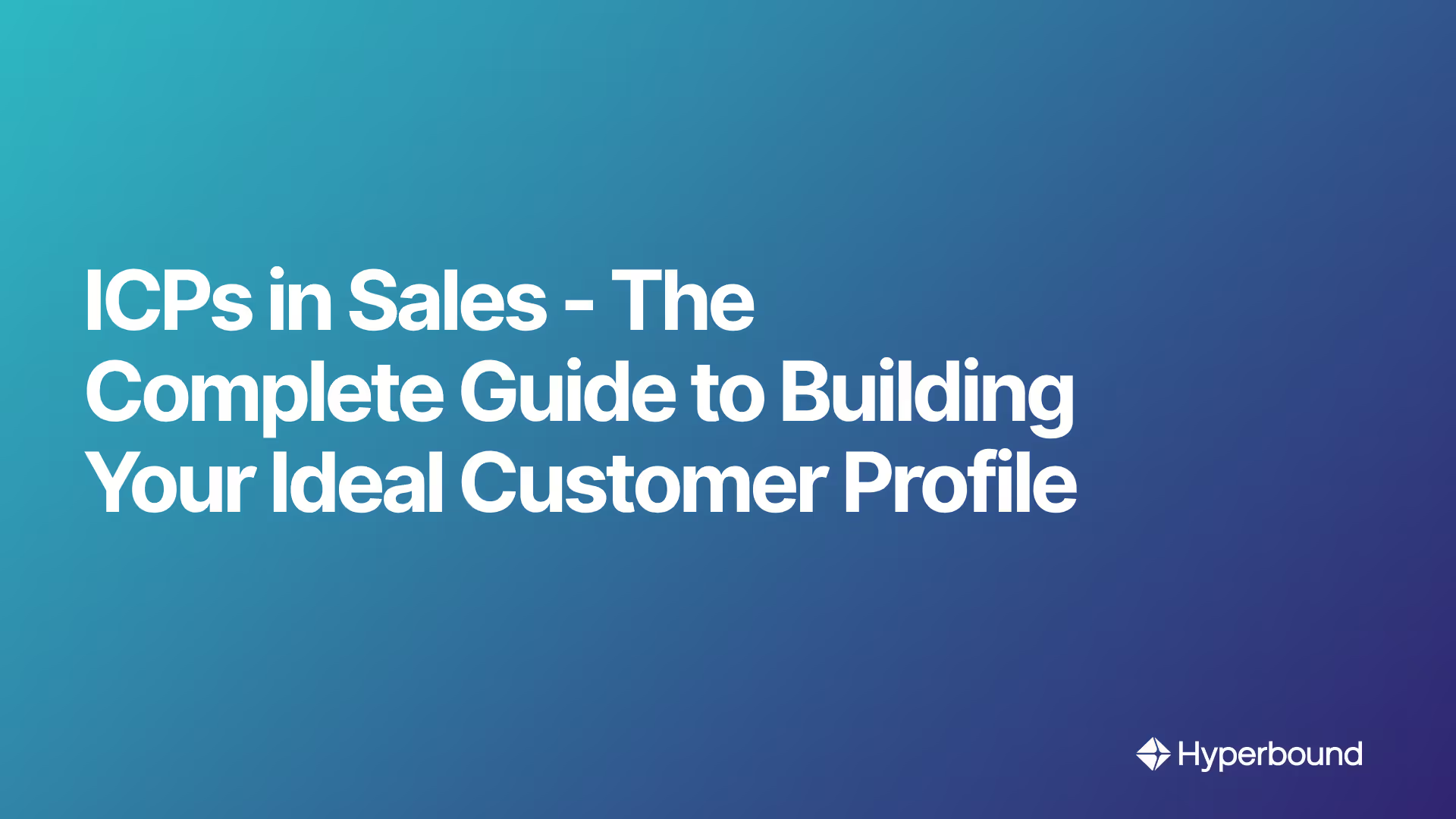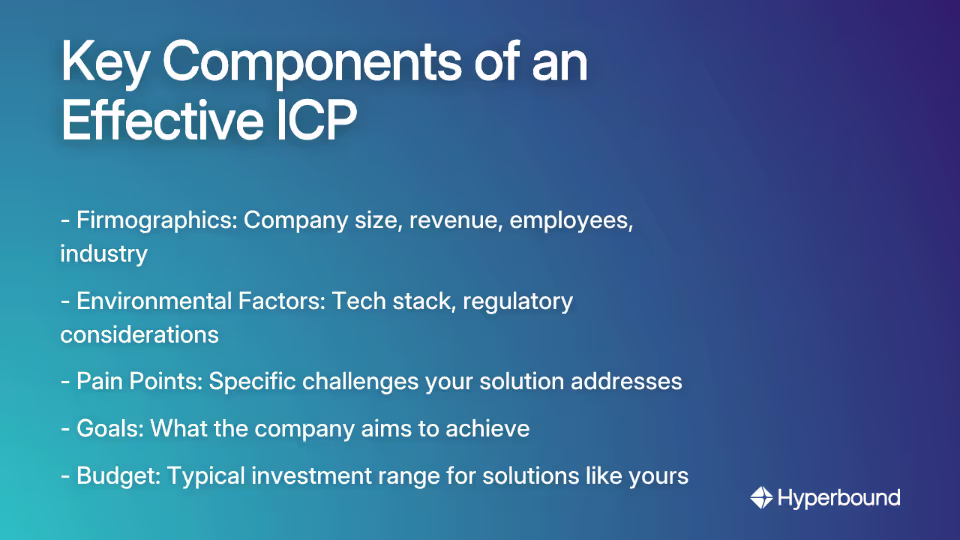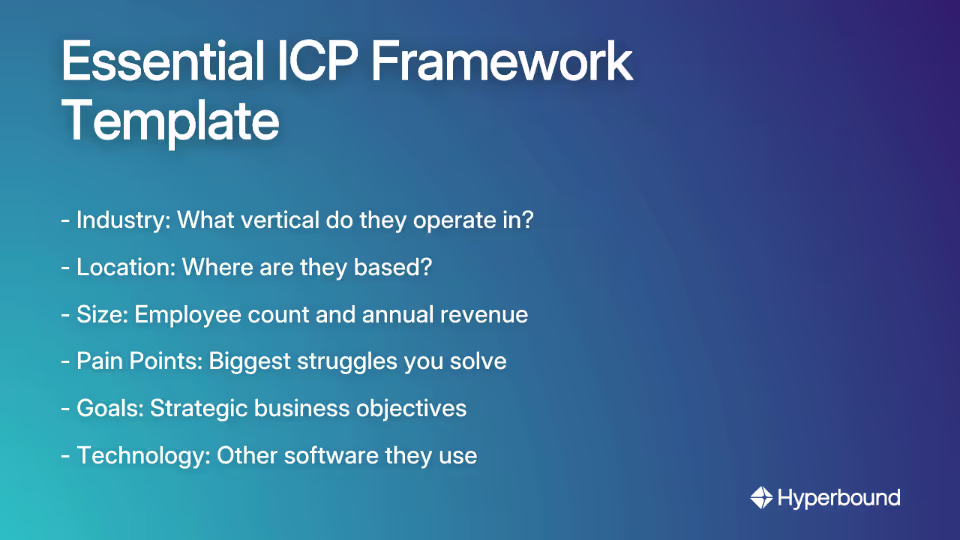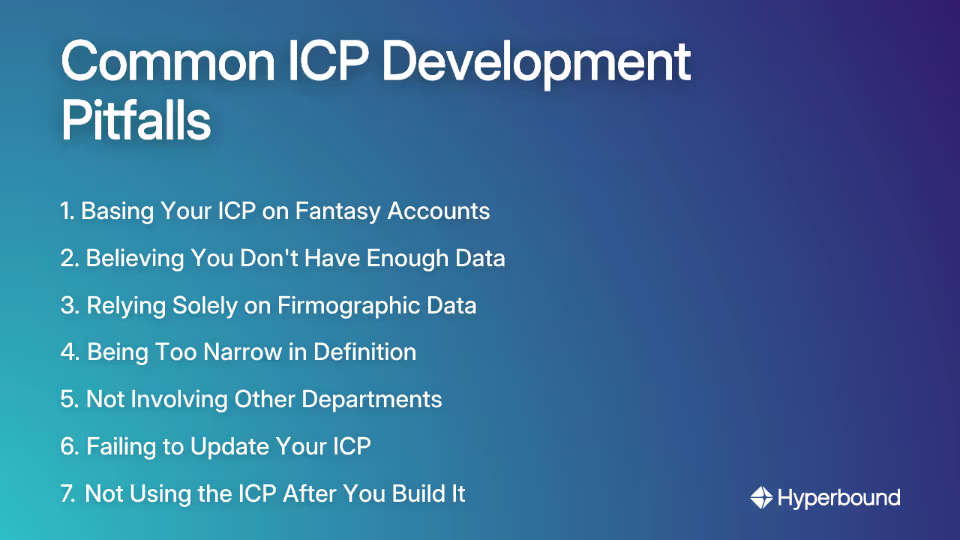
You've set up your business and are ready to sell. But when someone asks who your target audience is, you hesitate. "Anyone who needs my product," you think. After all, wouldn't limiting yourself to a specific group be... restrictive?
This common confusion leads many business owners to cast too wide a net, wasting resources on prospects who will never convert while missing those who would be perfect customers.
Enter the Ideal Customer Profile (ICP) - not a limitation, but a strategic compass that focuses your efforts where they'll yield the best results.
What is an ICP? Understanding Ideal Customer Profiles
An Ideal Customer Profile (ICP) is a detailed description of a fictitious company that represents your perfect customer - one that gains significant value from your product or service while providing significant value to your business in return.
According to Qualtrics, your ICP serves as a template of companies that will benefit most from your solution and be the most lucrative for your business.
ICP vs. Buyer Persona: The Critical Distinction
Many confuse ICPs with buyer personas, but they serve different purposes:
- ICP (the company): Focuses on the account level - the type of organization you should be selling to. This is essential in B2B landscapes and Account-Based Marketing (ABM).
- Buyer Persona (the person): Represents the individuals within your ICP companies, focusing on their goals, motivations, and challenges.
For example, your ICP might be mid-sized hotel chains, but you could have multiple buyer personas within that ICP, such as "Operations Olivia" (the manager) or "Finance Frank" (the CFO).
Key Components of an Effective ICP
A comprehensive ICP typically includes:
- Firmographics: Company size, annual revenue, number of employees, industry/vertical, geographic location
- Environmental Factors: Technology stack, legal/regulatory considerations
- Pain Points: Specific challenges your solution addresses
- Goals: What the company aims to achieve
- Budget: Typical investment range for solutions like yours

The Game-Changing Impact of a Well-Defined ICP
Far from being a mere theoretical exercise, developing an ICP delivers concrete business results:
Dramatically Increase Revenue and Win Rates
The numbers speak for themselves:
- Companies with a strong ICP achieve 68% higher win rates according to SuperOffice research
- Having the right ICP makes you 67% more likely to exceed your sales quota as reported in this LinkedIn analysis
- New Breed increased their average deal size by 83% in one year simply by refining their ICP as detailed in their case study
Stop Wasting Time and Resources
The cost of pursuing wrong-fit customers is staggering:
- At least 50% of your prospects are not a good fit for what you sell, according to Sales Insights Lab research
- Gartner predicts that by 2025, 75% of companies will "break up" with poor-fit customers to cut their losses, highlighting the growing recognition of this issue
One Reddit user asked: "Wouldn't you want to sell a service to whomever needs it no matter who?" The truth is, not everyone who could use your product is someone who should use your product - at least not if you want to grow efficiently.
Power Your Marketing and Sales Engine
A well-defined ICP enables:
- Personalization: The fastest-growing companies drive 40% more revenue from personalization than slower-growing counterparts, according to McKinsey research
- Account-Based Marketing: An ICP is the cornerstone of ABM, a strategy used by 94% of B2B marketers to target high-value accounts

How to Build Your ICP: A Step-by-Step Guide
Now for the practical part - how do you actually create an effective ICP?
Step 1: Identify and List Your "Best" Customers
Don't start with a hypothesis. Start with data:
- Compile a list of your most successful existing customers
- Define "best" using metrics like:
For new businesses without a large customer base, one Reddit user advises: "Get it 80% of the way there through customer conversations" and conduct competitor research to see who their best customers are.
Step 2: Analyze and Interview for Deep Insights
This step is crucial. As another marketer emphasized: "You can't just go off pure hypothesis either. Start having conversations with customers fitting that profile to really understand their problems."
Gather both:
- Quantitative data from your CRM on firmographic and behavioral characteristics
- Qualitative insights through customer interviews with questions like:
- "What were the biggest challenges you faced before you found our solution?"
- "Why did you choose us over competitors?"
- "What does success look like for your business?"
Step 3: Compile Attributes and Define Pain Points
Look for patterns in your data and interviews to identify the 5-10 most common attributes of your best customers. Use a template framework to organize this information:
- Industry: What vertical do they operate in?
- Location: Where are they based?
- Size: What is their employee count and annual revenue?
- Pain Points: What are their biggest struggles that you solve?
- Goals: What are their strategic business objectives?
- Technology: What other software do they use?

Step 4: Define Your Unique Value Proposition (USP)
Clearly articulate how your product or service uniquely solves the specific challenges and helps achieve the goals you identified in the previous step. This is about creating value, not just pushing a product.
Step 5: Document, Share, and Get Feedback
Create an official, shareable document for your ICP. You can build a simple template using the framework from Step 3 to get started.
Share it across departments—sales, marketing, product, and customer service—for feedback. A marketing-only perspective often overlooks practical insights from the front lines.
7 Common Mistakes to Avoid When Building Your ICP
Even with the best intentions, these pitfalls can undermine your ICP efforts:

- Basing Your ICP on Fantasy Accounts: Don't model your ICP on Google if your best customers are mid-sized startups. Base it on your actual successful clients.
- Believing You Don't Have Enough Data: Start with what you have. Even analyzing website traffic can reveal the types of companies interested in you.
- Relying Solely on Firmographic Data: One Reddit marketer warned: "A lot of people focus too much on job titles and forget to look at behavior. What makes someone actually ready to buy or use your product?"
- Being Too Narrow: Your ICP should be a guide, not a straitjacket. Focus on general needs and attitudes rather than overly specific criteria.
- Not Involving Other Departments: Sales and customer service teams have invaluable insights into customer pain points and successes.
- Failing to Update Your ICP: Markets shift, your product evolves, and customer needs change. Revisit your ICP at least biannually.
- Not Using the ICP After You Build It: The ICP should actively inform your marketing campaigns, content creation, and sales outreach.
Putting Your ICP to Work
Once you've built your ICP, here's how to activate it across your business:
- Supercharge Your Prospecting: Use your ICP to build targeted account lists for your sales team
- Smarter Lead Scoring: Qualify and score new inbound leads based on ICP fit
- Highly Targeted Advertising: Create hyper-targeted ad campaigns on platforms like LinkedIn
- Relevant Content Creation: Craft blog posts, whitepapers, and case studies that speak directly to your ICP's pain points
- Enable Your Sales Team: Translate your ICP into conversational mastery. Use it to build realistic training scenarios on a platform like Hyperbound. AI roleplays allow reps to practice handling objections and navigating conversations specific to your ideal customer, ensuring they are prepared for real-world calls.
Your ICP as a Living Document
The most successful companies treat their ICP as a living document that evolves with their business. Schedule biannual reviews to ensure it remains relevant as your market and offerings change.
Remember, as one sales professional noted: "It's not just about pushing a product; it's about creating value." Your ICP helps you identify who will receive the most value from what you offer.
Defining your Ideal Customer Profile isn't about restricting your opportunities—it's about focusing your efforts where they'll generate the greatest impact. By deeply understanding your best-fit customers, you can create genuine connections, build lasting relationships, and develop a customer-first approach that drives sustainable growth.
So rather than seeing your ICP as a limitation, view it as your roadmap to more efficient growth, higher win rates, and ultimately, a more successful business.
Frequently Asked Questions
What is an Ideal Customer Profile (ICP)?
An Ideal Customer Profile (ICP) is a detailed description of the perfect company for your product or service. It's a fictitious organization that represents the type of business that gains the most value from your solution and, in turn, provides the most value to your business. This profile is built using data points like company size, industry, revenue, and specific pain points.
What is the difference between an ICP and a buyer persona?
The main difference is that an ICP describes the ideal company (account level), while a buyer persona describes the ideal individual (person level) within that company. For a B2B business, you first identify your ICP (e.g., mid-sized SaaS companies in North America). Then, you create buyer personas for the key decision-makers within those companies (e.g., "Marketing Mary," the Head of Marketing).
Why is having an ICP so important for a business?
Having a well-defined ICP is crucial because it focuses your sales and marketing efforts, leading to higher efficiency, increased win rates, and better resource allocation. Instead of casting a wide, ineffective net, an ICP acts as a strategic compass. It helps you personalize marketing messages, qualify leads more effectively, and stop wasting time on prospects who are not a good fit.
How do I create an ICP if my business is new and has no customers?
If you're a new business without customer data, you can create a preliminary ICP by conducting market and competitor research. Start by analyzing your direct competitors to see what types of companies they are successfully selling to. You can also conduct interviews with potential customers who you believe fit your target profile to understand their needs and pain points. This initial "hypothesis" ICP can then be refined as you acquire your first customers.
How specific should my Ideal Customer Profile be?
Your ICP should be specific enough to guide your marketing and sales teams effectively, but not so narrow that it becomes a straitjacket. Focus on the key attributes that truly define a good-fit customer, such as industry, company size, and core pain points. Avoid getting bogged down in overly restrictive details that might exclude potentially great customers. It's a balance between focus and flexibility.
How often should I update my ICP?
You should treat your ICP as a living document and plan to review and update it at least once or twice a year. Markets evolve, your product changes, and your customers' needs shift over time. Regular updates ensure your ICP remains an accurate and relevant tool for your business. Schedule biannual reviews to ensure it remains current.
Is an ICP only useful for B2B companies?
While the term ICP is most commonly used in a B2B (business-to-business) context, the underlying principle is valuable for B2C (business-to-consumer) companies as well. B2C companies often use "target audience" or "customer profiles" which are conceptually similar. The goal is the same: to define the characteristics of the most valuable customers to focus marketing and product development efforts.

Book a demo with Hyperbound
.png)













